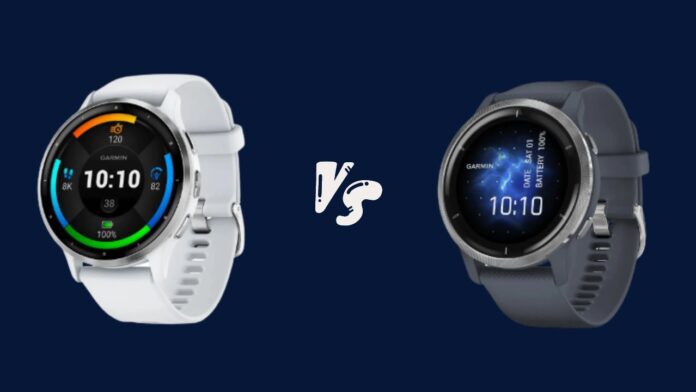The Garmin Venu series, as opposed to the more durable Instincts or specialized Forerunners, is aimed towards mainstream fitness enthusiasts. They highlight Garmin’s efforts to create a more typical smartwatch, introducing new capabilities before any other Garmin watch. The Garmin Venu 3 is no exception, with considerable improvements over the 2021 Venu 2.
The Garmin Venu 3 is, in many ways, the successor to last year’s Garmin Venu 2 Plus. It includes the same microphone and speaker as before for Bluetooth calls and smart assistant commands, as well as a third button for shortcuts. The Venu 3 costs the same as the Plus, $450, but adds exclusive features like Sleep Coaching, the new Garmin Elevate v5 heart rate sensor, and post-workout recovery advice.
If you own the Venu 2 and are debating whether to upgrade or save money with a reduced Venu 2, we’re here to help. First, we’ll look at everything that is the same between the two watches. Then, we’ll compare the Garmin Venu 3 vs. 2 stats and features to see if the upgrade is worthwhile.
What’s the Difference Between the Garmin Venu 3 and the Venu 2?
Garmin followed a similar pattern with the Venu 3 and Venu 2. These two watches have several commonalities, which we’ll go through below:
| Category | Garmin Venu 2 | Garmin Venu 3 |
|---|---|---|
| Display | 1.3-inch (416×416) or 1.1-inch (360×360) AMOLED touchscreen | 1.4-inch (454×454) or 1.2-inch (390×390) AMOLED touchscreen |
| Materials | Stainless steel bezel, fiber-reinforced polymer case | Stainless steel bezel, fiber-reinforced polymer case |
| Protection | 5ATM, Gorilla Glass 3 | 5ATM, Gorilla Glass 3 |
| Dimensions | 45.4 x 45.4 x 12.2 mm or 40.4 x 40.4 x 12.1 mm | 45 x 45 x 12 mm or 41 x 41 x 12 mm |
| Weight | 49g or 38g | 47g or 40g |
| Watch strap | 22mm or 18mm, quick-release | 22mm or 18mm, quick-release |
| Sensors | Garmin Elevate v4, SpO2, altimeter, compass, accelerometer, gyroscope, thermometer, ambient light | Garmin Elevate v5, SpO2, altimeter, compass, accelerometer, gyroscope, thermometer, ambient light |
| GPS tracking | GPS only | GPS-only or All-Systems GNSS |
| Mic and speaker | No | Yes |
| Music storage | 8GB | 8GB |
| Connectivity | Bluetooth, ANT+, Wi-Fi, NFC | Bluetooth, ANT+, Wi-Fi, NFC |
Design: Both watches are available in two sizes and are made of the same materials: stainless steel for the bezel and reinforced plastic for the body. The 45mm Venus features 22mm quick-release bands, while the 41mm Venus features 18mm bands.
Although the proportions of the Venu 3 and 2 differ somewhat — the Venu 3 is 2g lighter than the 2, while the Venu 3S is 2g heavier than the 2S — they’re roughly the same size and will feel the same on your wrist. They are also water resistant and have Gorilla Glass protection.
Connectivity: Both watches support Bluetooth sync, Wi-Fi uploads and downloads, Garmin Pay, and ANT+ accessories.
Sensors: The Venu 3 does have the new Elevate v5 optical heart rate sensor (more on that below), but everything else is the same. The Pulse Ox sensor measures blood oxygen, the altimeter measures elevation, the compass measures navigation, the ambient light measures display adjustments, and the accelerometer/gyroscope measures movement for step-counting and gym workouts.
Read Also: Best Smartwatches for Blood Pressure Monitoring in 2023
Core health and training data: The Garmin software package you know and love is included with the Venu 2: heart rate zones, intensity minutes, Body Battery, fitness age, Livetrack, animated on-screen workouts, and a Health Snapshot.
Music storage: Each Venu watch comes with 8GB of storage. You have plenty of room for your own MP3 files or playlists from Spotify, Amazon Music, or Deezer, in addition to anything you download through Connect IQ.
Garmin Venu 3 Compared. Garmin Venu 2: Hardware and Battery Life
The most noticeable Garmin Venu 3 improvement is the display. Both sizes increase the display space by 0.1 inch, from 1.1 and 1.3 to 1.2 and 1.4. Garmin reduced the visible display border of the Venu 2 to provide the Venu 3 more visual space without dramatically affecting the size.
In fact, Garmin managed to make the Venu 3 slightly thinner than the Venu 2 while integrating the built-in microphone and speaker. For reference, the 1.3-inch Garmin Venu 2 Plus is 0.6mm thicker and weighs 4g more than the 1.4-inch Venu 3.
We’re currently waiting for Garmin to deliver us the Venu 3, so we can’t test the mic and speaker quality just yet. Our reviewer noted that his voice “came through clearly to my call recipients on the other side” with the Venu 2 Plus, but he was less pleased with the speaker, finding it “tinny” and difficult to hear except in a hushed room. We’re hoping for a slight improvement with the Venu 3, but even if it’s the same quality, a tinny speaker is better than none at all.
The microphone also allows you to control your phone’s primary smart assistant, such as Google Assistant, Bixby, or Siri. Given that many Wear OS watches no longer include Google Assistant, it’s wonderful to have it on a Garmin watch.
The speaker, on the other hand, offers auditory suggestions during guided exercises such as intervals, so you don’t have to glance at your watch to know what to do next.
The Garmin Venu 2 only supports GPS, GLONASS, and GALILEO separately. You can use the Garmin Venu 3’s All-Systems mode to better determine your location in places where one satellite signal may be degraded.
Another important hardware difference is that the Garmin Venu 3 has a significantly longer battery life. The Venu 2 had good battery life for its time, but it couldn’t handle an always-on display, the energy saver option didn’t live up to its name, and using GPS with music depleted the battery far too quickly.
The Venu 3 performs significantly better in these locations, and its All-Systems mode lasts nearly as long as the Venu 2’s GPS-only mode. Except for the AOD or Battery Saver modes, the Venu 3S isn’t significantly better than the 2S, with the same 10-day maximum for ordinary use.
The Venu 3’s final significant distinction is the new Elevate v5 optical heart rate sensor. Garmin hasn’t specified what makes this new sensor superior; we do know that it has more LEDs, which should result in more precise readings.
We also know, due to DC Rainmaker, that the Venu 3 can take ECG readings, exactly as the Venu 2 Plus, but that it isn’t yet operational because it requires FDA approval. He also says that the Elevate v5 sensor can take skin temperature readings, which Gadgets & Wearables confirmed by discovering Garmin Connect screenshots of a new skin temperature widget.
So, theoretically, the Garmin Venu 3 will be able to support two new health measures that the Venu 2 cannot. Even though the Elevate v5 enables these features, we cannot promise that Garmin will activate them on the Venu 3; hidden hardware limits sometimes prevent technically-possible features from working on specific models.
So, even if it is likely, we wouldn’t buy the Venu 3 expecting to obtain ECG and skin temperature data. ECG is the most likely of the two.
Finally, while both the Venu 3 and Venu 2 offer Pulse Ox tracking, only the Venu 3 will support Jet Lag Adviser, which will help you determine how well you’ve recovered from traveling around the world and alter your fitness data accordingly.
Garmin Venu 3 vs. Garmin Venu 2: Software Upgrades
You may have heard that for the first time, the Venu 3 will support Sleep Coaching and nap tracking. After a night’s sleep, you’ll receive a Morning Report based on your age, daily and long-term activity levels, recent sleep history, naps taken, and heart rate variability (HRV).
It is generally recommended that you sleep between 7 and 9 hours per night. You can try to compensate for missing sleep by napping during the day; the Garmin Venu 3 will track your midday sleep time and factor it into your Body Battery and sleep coaching.
In terms of Body Battery, the Garmin Venu 3 will analyze your workouts and prescribe recuperation times based on your current fitness level (aka VO2 Max) and exhaustion. To help steer these recommendations, you’ll be able to estimate your “rate of perceived exertion,” which simply means you’ll tap one of five emoji faces to rate how strong to injured you feel.
Other modest but significant new features include guided meditations, the ability to construct interval workouts on your watch, and the option to change the font size to a bigger, more readable size.
We’re especially excited that the Garmin Venu 3 will include wheelchair workouts for the first time: it will count pushes instead of steps and will remind you to redistribute your weight instead of getting up and stretching. It will assess your effort using a different metric since “upper body exercise typically produces greater physiological strain than lower body exercise at similar workloads,” which “can result in earlier fatigue onset during exercise.”
Snowshoeing, Tennis, Padel, Pickleball, eBiking, Handcycling, and Indoor Handcycling are additional new sports modalities. The Garmin Venu 3 does not offer as many sports modes as other Garmin watches, but the list is gradually expanding.
While these are the main differences, we dug through the Garmin Venu 3 and 2 spec sheets to find more upgrades you might be interested in. We discovered the following Garmin Venu 3 specific software tools:
- Connect IQ on-device shop
- The Garmin GameOn app is supported.
- Power meters, eBikes, and Smart Trainers are all supported Control.
- Training with intervals: Open repeats, an interval data page, a rest screen, and auto detection are all available.
- New open-water swim stats and Auto-Rest detection while swimming in the pool.
Should You Buy the Garmin Venu 3 or the Venu 2?
Upgrading to the Garmin Venu 3 adds All-Systems GNSS, much better battery life (especially with AOD active), Sleep Coaching, a mic and speaker for Bluetooth calls, a third programmable button for bringing up your favorite widgets, a larger AMOLED display, recovery recommendations, and wheelchair exercises, as well as the possibility of ECG and skin temperature readings in the future.
Venu 2 users have every reason to be enticed by the Venu 3; and anyone thinking about spending $50-$100 on the Venu 2 instead of the Venu 3 should consider the consequences of missing out on all of these new tools.
If you own the Garmin Venu 2 Plus, our current recommendation for the best fitness wristwatch, the decision is significantly more difficult because you must have purchased it recently. After all, you already have the microphone, speaker, ECG readings, and third button. Despite its less outstanding 9-day battery life, investing extra $450 on the Venu 3 for decreasing rewards may be unwise. The only exception is if you want a special update, such as power meter compatibility or wheelchair mode.
Finally, we’re pleased with everything the Garmin Venu 3 has to offer. We wish it included training load, Training Readiness, suggested workouts, multisport mode, dual-frequency GPS, and other features seen on comparable $450 Garmin watches like as the Forerunner 265 or Instinct 2X Solar. However, this is a significant step forward in keeping the Venu series current.


















![10 Countries With the Best Healthcare in the World [Statistical Analysis] Countries With the Best Healthcare in the World](https://articleify.com/wp-content/uploads/2025/07/Countries-With-the-Best-Healthcare-in-the-World-1-150x150.jpg)










